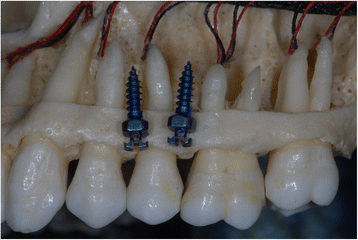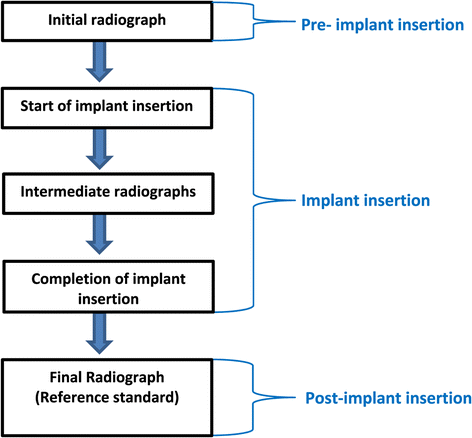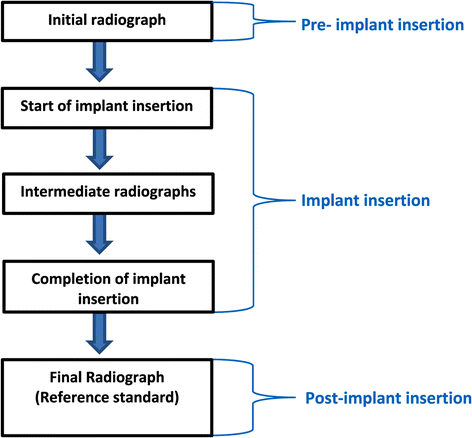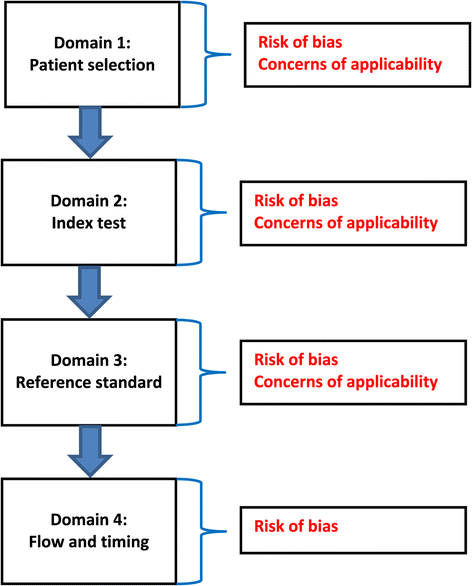Insertion torque recordings for the diagnosis of contact between orthodontic mini-implants and dental roots: protocol for a systematic review
- PMID: 25875916
- PMCID: PMC4407834
- DOI: 10.1186/s13643-015-0014-6
Insertion torque recordings for the diagnosis of contact between orthodontic mini-implants and dental roots: protocol for a systematic review
Abstract
Background: Hitting a dental root during the insertion of orthodontic mini-implants (OMIs) is a common adverse effect of this intervention. This condition can permanently damage these structures and can cause implant instability. Increased torque levels (index test) recorded during the insertion of OMIs may provide a more accurate and immediate diagnosis of implant-root contact (target condition) than radiographic imaging (reference standard). An accurate index test could reduce or eliminate X-ray exposure. These issues, the common use of OMIs, the high prevalence of the target condition, and because most OMIs are placed between roots warrant a systematic review. We will assess 1) the diagnostic accuracy and the adverse effects of the index test, 2) whether OMIs with root contact have higher insertion torque values than those without, and 3) whether intermediate torque values have clinical diagnostic utility.
Methods: The Preferred Reporting Items for Systematic review and Meta-Analysis Protocols (PRISMA-P) 2015 statement was used as a the guideline for reporting this protocol. Inserting implants deliberately into dental roots of human participants would not be approved by ethical review boards and adverse effects of interventions are generally underreported. We will therefore apply broad spectrum eligibility criteria, which will include clinical, animal and cadaver models. Not including these models could slow down knowledge translation. Both randomized and non-randomized research studies will be included. Comparisons of interest and subgroups are pre-specified. We will conduct searches in MEDLINE and more than 40 other electronic databases. We will search the grey literature and reference lists and hand-search ten journals. All methodological procedures will be conducted by three reviewers. Study selection, data extraction and analyses, and protocols for contacting authors and resolving conflicts between reviewers are described. Designed specific risk of bias tools will be tailored to the research question. Different research models will be analysed separately. Parameters for exploring statistical heterogeneity and conducting meta-analyses are pre-specified. The quality of evidence for outcomes will be assessed through the Grading of Recommendations Assessment, Development and Evaluation (GRADE) approach.
Discussion: The findings of this systematic review will be useful for patients, clinicians, researchers, guideline developers, policymakers, and surgical companies.
Figures





Similar articles
-
Barriers and facilitators to the implementation of orthodontic mini-implants in clinical practice: a protocol for a systematic review and meta-analysis.Syst Rev. 2016 Feb 5;5:22. doi: 10.1186/s13643-016-0198-4. Syst Rev. 2016. PMID: 26846440 Free PMC article.
-
Microcomputed tomographic analysis of bone reaction at insertion of orthodontic mini-implants in sheep.Int J Oral Maxillofac Implants. 2011 Nov-Dec;26(6):1233-40. Int J Oral Maxillofac Implants. 2011. PMID: 22167428
-
Influence of defect depth on resonance frequency analysis and insertion torque values for implants placed in fresh extraction sockets: a human cadaver study.Clin Implant Dent Relat Res. 2009 Mar;11(1):52-8. doi: 10.1111/j.1708-8208.2008.00095.x. Epub 2008 Apr 1. Clin Implant Dent Relat Res. 2009. PMID: 18384400
-
The influence of insertion torque values on the failure and complication rates of dental implants: A systematic review and meta-analysis.Clin Implant Dent Relat Res. 2021 Jun;23(3):341-360. doi: 10.1111/cid.12993. Epub 2021 Mar 25. Clin Implant Dent Relat Res. 2021. PMID: 33764648
-
Dental roots' and surrounding structures' response after contact with orthodontic mini implants: A systematic literature review.Stomatologija. 2018;20(3):73-81. Stomatologija. 2018. PMID: 30531161
Cited by
-
Barriers and facilitators to the implementation of orthodontic mini-implants in clinical practice: a protocol for a systematic review and meta-analysis.Syst Rev. 2016 Feb 5;5:22. doi: 10.1186/s13643-016-0198-4. Syst Rev. 2016. PMID: 26846440 Free PMC article.
-
Contacting of authors by systematic reviewers: protocol for a cross-sectional study and a survey.Syst Rev. 2017 Dec 8;6(1):249. doi: 10.1186/s13643-017-0643-z. Syst Rev. 2017. PMID: 29216930 Free PMC article.
-
Insertion torque recordings for the diagnosis of contact between orthodontic mini-implants and dental roots: a systematic review.Syst Rev. 2016 Mar 31;5:50. doi: 10.1186/s13643-016-0227-3. Syst Rev. 2016. PMID: 27036120 Free PMC article.
-
Barriers and facilitators to the implementation of orthodontic mini implants in clinical practice: a systematic review.Syst Rev. 2016 Sep 23;5(1):163. doi: 10.1186/s13643-016-0336-z. Syst Rev. 2016. PMID: 27662827 Free PMC article.
References
-
- Antoszewska J, Trześniewska P, Kawala B, Ludwig B, Park H-S. Qualitative and quantitative evaluation of root injury risk potentially burdening insertion of miniscrew implants. Korean J Orthod. 2011;41(2):112–20. doi: 10.4041/kjod.2011.41.2.112. - DOI
MeSH terms
Substances
LinkOut - more resources
Full Text Sources
Other Literature Sources
Medical

